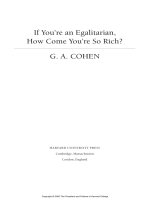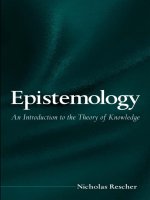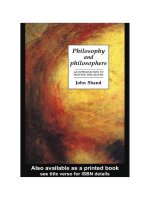harvard university press articulating reasons an introduction to inferentialism may 2000
Bạn đang xem bản rút gọn của tài liệu. Xem và tải ngay bản đầy đủ của tài liệu tại đây (2.12 MB, 240 trang )
Articulating Reasons
Copyright © 2000 The President and Fellows of Harvard College
Copyright © 2000 The President and Fellows of Harvard College
◆ ◆ ◆
Articulating
Reasons
AN INTRODUCTION
TO INFERENTIALISM
Robert B. Brandom
Harvard University Press
Cambridge, Massachusetts
London, England
Copyright © 2000 The President and Fellows of Harvard College
Copyright © 2000 by the President and Fellows of Harvard College
All rights reserved
Printed in the United States of America
Second printing, 2001
First Harvard University Press paperback edition, 2001
Library of Congress Cataloging-in-Publication Data
Brandom, Robert.
Articulating reasons : an introduction to inferentialism / Robert B. Brandom.
p. cm.
Includes bibliographical references and index.
ISBN
0-674-00158-3 (cloth)
ISBN
0-674-00692-5 (pbk.)
1. Language and languages—Philosophy. 2. Semantics (Philosophy)
3. Inference. 4. Reasoning. 5. Language and logic. 6. Expression
(Philosophy) I. Title.
P
106.
B
6938 2000
121'.68—dc21 99-05775 6
Copyright © 2000 The President and Fellows of Harvard College
To my wife, Barbara, whose loving support
and patient indulgence over the years
mean more to me than I can say
Copyright © 2000 The President and Fellows of Harvard College
Copyright © 2000 The President and Fellows of Harvard College
◆ ◆ ◆
Acknowledgments
The lectures on which this book is based evolved under the influ-
ence of the responses of many audiences to which different ver-
sions have been presented in recent years. Here and there it has
been possible to acknowledge particular contributions, but the
cumulative effect of all those smart people thinking these things
through with me—and the debt I owe for it—is incalculable. I am
profoundly grateful.
Copyright © 2000 The President and Fellows of Harvard College
Copyright © 2000 The President and Fellows of Harvard College
◆ ◆ ◆
Contents
Acknowledgements
Introduction 1
1 Semantic Inferentialism and Logical Expressivism 45
2 Action, Norms, and Practical Reasoning 79
3 Insights and Blindspots of Reliabilism 97
4 What Are Singular Terms, and Why Are There Any? 123
5 A Social Route from Reasoning to Representing 157
6 Objectivity and the Normative
6 Fine Structure of Rationality 185
Notes 205
Index 222
Copyright © 2000 The President and Fellows of Harvard College
Copyright © 2000 The President and Fellows of Harvard College
◆ ◆ ◆
Introduction
I. Strategic Context: The Nature of the Conceptual
This is a book about the use and content of concepts. Its animating
thought is that the meanings of linguistic expressions and the con-
tents of intentional states, indeed, awareness itself, should be
understood, to begin with, in terms of playing a distinctive kind of
role in reasoning. The idea of privileging inference over reference in
the order of semantic explanation is introduced and motivated in
the first chapter. Subsequent chapters develop that approach by
using it to address a variety of philosophically important issues and
problems: practical reasoning and the role of normative concepts
in the theory of action, perception and the role of assessments of
reliability in epistemology, the expressive role distinctive of singu-
lar terms and predicates (which, as subsentential expressions, can-
not play the directly inferential role of premise or conclusion),
propositional attitude ascriptions and the representational dimen-
sion of concept use, and the nature of conceptual objectivity.
Although the discussion is intended to be intelligible in its own
right—in each individual chapter, as well as collectively—it may
nonetheless be helpful to step back a bit from the project pursued
here and to situate it in the larger context of theoretical issues,
possibilities, and approaches within which it takes shape.
Copyright © 2000 The President and Fellows of Harvard College
2
◆
Introduction
The overall topic is the nature of the conceptual as such. This
choice already entails certain significant emphases of attention:
within the philosophy of mind, on awareness in the sense of
sapience rather than of mere sentience; within semantics, on
specifically conceptual content, to the detriment of concern with
other sorts of contentfulness; within pragmatics, on singling
out discursive (that is, concept-using) practice from the back-
ground of various other kinds of skillful doing. The aim is to focus
on the conceptual in order to elaborate a relatively clear notion of
the kind of awareness of something that consists in applying a con-
cept to it—paradigmatically by saying or thinking something
about it.
Addressing this topic requires making a series of choices of fun-
damental explanatory strategy. The resulting commitments need
to be brought out into the open because they shape any approach
to the conceptual in such important ways. Making this back-
ground of orienting commitments explicit serves to place a view in
a philosophical space of alternatives. Features of an account that
otherwise express nearly invisible (because only implicit) assump-
tions then show up as calling for decisions, which are subject to
determinate sorts of challenges and demands for justification. The
major axes articulating the region inhabited by the line of thought
pursued here can be presented as a series of stark binary opposi-
tions, which collectively make it possible to map the surrounding
terrain.
1. Assimilation or Differentiation of the Conceptual?
One fork in the methodological road concerns the relative priority
accorded to the continuities and discontinuities between dis-
cursive and nondiscursive creatures: the similarities and differ-
ences between the judgments and actions of concept users, on the
one hand, and the uptake of environmental information and
Copyright © 2000 The President and Fellows of Harvard College
◆
Introduction 3
instrumental interventions of non–concept-using organisms and
artifacts, on the other. We can ask how sharp this distinction is—
that is, to what extent and in what ways the possibility of inter-
mediate cases can be made intelligible. And more or less indepen-
dently of the answer to this question, it is possible for theorists
to differ as to whether they start by describing a common genus
and go on to elaborate differentiae (whether qualitative or in
terms of some quantitative ordering by a particular kind of com-
plexity), as opposed to beginning with an account of what is dis-
tinctive of the conceptual, which is only later placed in a larger
frame encompassing the doings of less capable systems. Of course,
wherever the story starts, it will need to account both for the
ways in which concept use is like the comportments of non-
discursive creatures and the ways in which it differs. Theories that
assimilate conceptually structured activity to the nonconceptual
activity out of which it arises (in evolutionary, historical, and
individual-developmental terms) are in danger of failing to make
enough of the difference. Theories that adopt the converse strat-
egy, addressing themselves at the outset to what is distinctive of
or exceptional about the conceptual, court the danger of not
doing justice to generic similarities. The difference in emphasis
and order of explanation can express substantive theoretical com-
mitments.
Along this dimension, the story told here falls into the second
class: dis continuities between the conceptual and non- or precon-
ceptual are to the fore. The discussion is motivated by a concern
with what is special about or characteristic of the conceptual as
such. I am more interested in what separates concept users from
non–concept users than in what unites them. This distinguishes
my project from that of many in contemporary semantic theory
(for instance, Dretske, Fodor, and Millikan), as well as from the
classical American pragmatists, and perhaps from the later Witt-
genstein as well.
Copyright © 2000 The President and Fellows of Harvard College
4
◆
Introduction
2. Conceptual Platonism or Pragmatism?
Here is another strategic methodological issue. An account of the
conceptual might explain the use of concepts in terms of a prior
understanding of conceptual content. Or it might pursue a com-
plementary explanatory strategy, beginning with a story about the
practice or activity of applying concepts, and elaborating on that
basis an understanding of conceptual content. The first can be
called a platonist strategy, and the second a pragmatist (in this
usage, a species of functionalist) strategy. One variety of semantic
or conceptual platonism in this sense would identify the content
typically expressed by declarative sentences and possessed by
beliefs with sets of possible worlds, or with truth conditions other-
wise specified. At some point it must then explain how associating
such content with sentences and beliefs contributes to our under-
standing of how it is proper to use sentences in making claims, and
to deploy beliefs in reasoning and guiding action. The pragmatist
direction of explanation, by contrast, seeks to explain how the use
of linguistic expressions, or the functional role of intentional
states, confers conceptual content on them.
The view expounded in these pages is a kind of conceptual
pragmatism (broadly, a form of functionalism) in this sense. It
offers an account of knowing (or believing, or saying) that such
and such is the case in terms of knowing how (being able) to do
something. It approaches the contents of conceptually explicit
propositions or principles from the direction of what is implicit in
practices of using expressions and acquiring and deploying beliefs.
‘Assertion’, ‘claim’, ‘judgment’, and ‘belief ’ are all systematically
ambiguous expressions—and not merely by coincidence. The sort
of pragmatism adopted here seeks to explain what is asserted by
appeal to features of assertings, what is claimed in terms of claim-
ings, what is judged by judgings, and what is believed by the role of
believings (indeed, what is expressed by expressings of it)—in
general, the content by the act, rather than the other way around.
Copyright © 2000 The President and Fellows of Harvard College
◆
Introduction 5
3. Is Mind or Language the Fundamental Locus
of Intentionality?
Concepts are applied in the realm of language by the public use of
sentences and other linguistic expressions. They are applied in the
realm of mind by the private adoption of and rational reliance on
beliefs and other intentional states. The philosophical tradition
from Descartes to Kant took for granted a mentalistic order of
explanation that privileged the mind as the native and original
locus of concept use, relegating language to a secondary, late-
coming, merely instrumental role in communicating to others
thoughts already full-formed in a prior mental arena within the
individual. The period since then has been characterized by a
growing appreciation of the significance of language for thought
and mindedness generally, and a questioning of the picture of lan-
guage as a more or less convenient tool for expressing thoughts
intelligible as contentful apart from any consideration of the pos-
sibility of saying what one is thinking. The twentieth century has
been the century of language in philosophical thought, acceler-
ating into something like a reversal of the traditional order of
explanation. Thus Dummett defends a linguistic theory of inten-
tionality: “We have opposed throughout the view of assertion as
the expression of an interior act of judgment; judgment, rather, is
the interiorization of the external act of assertion.”
1
Dummett’s
claim is emblematic of views (put forward in different forms by
thinkers such as Sellars and Geach) that see language use as an-
tecedently and independently intelligible, and so as available to
provide a model on the basis of which one could then come to
understand mental acts and occurrences analogically: taking
thinking as a kind of inner saying. Such a view just turns the classi-
cal early modern approach on its head.
Davidson claims that to be a believer one must be an interpreter
of the speech of others, but that “neither language nor thinking
can be fully explained in terms of the other, and neither has
Copyright © 2000 The President and Fellows of Harvard College
6
◆
Introduction
conceptual priority. The two are, indeed, linked in the sense that
each requires the other in order to be understood, but the linkage
is not so complete that either suffices, even when reasonably re-
inforced, to explicate the other.”
2
Although Davidson shares
some important motivations with Dummett’s purely linguistic
theory, in fact these two views illustrate an important difference
between two ways in which one might give prominence to linguis-
tic practice in thinking about the use of concepts. Davidson’s
claim, by contrast to Dummett’s, serves to epitomize a relational
view of the significance of language for sapience: taking it that
concept use is not intelligible in a context that does not include
language use, but not insisting that linguistic practices can be
made sense of without appeal at the same time to intentional
states such as belief.
The line of thought pursued here is in this sense a relational lin-
guistic approach to the conceptual. Concept use is treated as an
essentially linguistic affair. Claiming and believing are two sides of
one coin—not in the sense that every belief must be asserted nor
that every assertion must express a belief, but in the sense that nei-
ther the activity of believing nor that of asserting can be made sense
of independently of the other, and that their conceptual contents
are essentially, and not just accidentally, capable of being the con-
tents indifferently of both claims and beliefs. In the context of the
commitment to the kind of explanatory relation between those
activities and those contents mentioned above, this approach takes
the form of a linguistic pragmatism that might take as its slogan
Sellars’s principle that grasping a concept is mastering the use of a
word. James and Dewey were pragmatists in the sense I have picked
out, since they try to understand conceptual content in terms of
practices of using concepts. But, in line with their generally assimi-
lationist approach to concept use, they were not specifically lin-
guistic pragmatists. The later Wittgenstein, Quine, and Sellars (as
well as Dummett and Davidson) are linguistic pragmatists, whose
strategy of coming at the meaning of expressions by considering
Copyright © 2000 The President and Fellows of Harvard College
◆
Introduction 7
their use provides a counterbalance to the Frege-Russell-Carnap-
Tarski platonistic model-theoretic approach to meaning.
4. The Genus of Conceptual Activity:
Representation or Expression?
Besides this issue about the original locus of the conceptual, there
is an issue about how to understand the genus of which it is a
species. (As I have indicated, this is no less urgent for theories that
concern themselves in the first instance with what is distinctive
of the conceptual species of that genus than it is for those adopt-
ing the assimilationist order of proceeding.) The master concept
of Enlightenment epistemology and semantics, at least since
Descartes, was representation. Awareness was understood in rep-
resentational terms—whether taking the form of direct awareness
of representings or of indirect awareness of representeds via repre-
sentations of them. Typically, specifically conceptual representa-
tions were taken to be just one kind of representation of which
and by means of which we can be aware. This orienting thought
remains active to this day, surviving the quite substantial trans-
formations required, for instance, for naturalistic and broadly
functional accounts of awareness by and of representations. The
result is a familiar, arguably dominant, contemporary research
program: to put in place a general conception of representation,
the simpler forms of which are exhibited already in the activity of
non–concept-using creatures, and on that basis elaborate ever
more complex forms until one reaches something recognizable as
specifically conceptual representation.
This representational paradigm
3
of what mindedness consists in
is sufficiently ubiquitous that it is perhaps not easy to think of
alternatives of similar generality and promise. One prominent
countertradition, however, looks to the notion of expression,
rather than representation, for the genus within which distinc-
tively conceptual activity can become intelligible as a species.
Copyright © 2000 The President and Fellows of Harvard College
8
◆
Introduction
To the Enlightenment picture of mind as mirror, Romanticism
opposed an image of the mind as lamp.
4
Broadly cognitive activity
was to be seen not as a kind of passive reflection but as a kind of
active revelation. Emphasizing the importance of experimental
intervention and the creative character of theory production
motivated an assimilation of scientific to artistic activity, of finding
as constrained making—a picture of knowing nature as producing
a second nature (to use Leonardo da Vinci’s phrase).
The sort of expressivism Herder initiated takes as its initial point
of departure the process by which inner becomes outer when a
feeling is expressed by a gesture.
5
We are then invited to consider
more complex cases in which attitudes are expressed in actions, for
instance, when a desire or intention issues in a corresponding
doing, or a belief in saying. So long as we focus on the simplest
cases, an expressivist model will not seem to offer a particularly
promising avenue for construing the genus of which conceptual
activity is a species (though one might say the same of the repre-
sentational model if attention is focused on, say, the imprint of a
seal on a wax tablet). But a suitable commentary on the model
may be able to repair this impression somewhat.
First, we might think of the process of expression in the more
complex and interesting cases as a matter not of transforming
what is inner into what is outer but of making explicit what is
implicit. This can be understood in a pragmatist sense of turning
something we can initially only do into something we can say: cod-
ifying some sort of knowing how in the form of a knowing that.
Second, as is suggested by this characterization of a pragmatist
form of expressivism, in the cases of most interest in the present
context, the notion of explicitness will be a conceptual one. The
process of explicitation is to be the process of applying concepts:
conceptualizing some subject matter. Third, we need not yield to
the temptation, offered by the primitive expressive relation of ges-
ture to feeling, to think of what is expressed and the expression of
it as individually intelligible independently of consideration of the
Copyright © 2000 The President and Fellows of Harvard College
◆
Introduction 9
relation between them. At least in the more interesting cases,
specification of what is implicit may depend on the possibility of
making it explicit. And the explicit may not be specifiable apart
from consideration of what is made explicit. On such a view, what
is expressed must be understood in terms of the possibility of
expressing it. Such a relational expressivism will understand lin-
guistic performances and the intentional states they express each
as essential elements in a whole that is intelligible only in terms of
their relation. According to such an approach, for instance, one
ought not to think that one can understand either believing or
asserting except by abstracting from their role in the process of
asserting what one believes (that is, this sort of expressivism has as
a consequence a relational linguistic view of the layout of the con-
ceptual realm).
Understanding the genus of which the conceptual is a species in
representational terms invites a platonist order of explanation.
That it does not demand one is clear from the possibility of psy-
chologically or linguistically functionalist accounts of representa-
tional content. Nonetheless, expressivism is particularly congenial
to a pragmatist order of semantic explanation, as is indicated by
the formulation of the relation between what is implicit and what
is explicit in terms of the distinction between knowing how and
knowing that. The account presented in the body of this work is
one kind of constitutive, pragmatist, relationally linguistic, con-
ceptual expressivism. The commitment to trying to make expres-
sivism work as a framework within which to understand concept
use and (so) conceptual content sets this project off from most
others on the contemporary scene. For a representational para-
digm reigns not only in the whole spectrum of analytically pur-
sued semantics, from model-theoretic, through possible worlds,
directly counterfactual, and informational approaches to teleo-
semantic ones, but also in structuralism inheriting the broad
outlines of Saussure’s semantics, and even in those later conti-
nental thinkers whose poststructuralism is still so far mired in the
Copyright © 2000 The President and Fellows of Harvard College
10
◆
Introduction
representational paradigm that it can see no other alternative to
understanding meaning in terms of signifiers standing for signi-
fieds than to understand it in terms of signifiers standing for other
signifiers. Even contemporary forms of pragmatism, which are
explicitly motivated by the rejection of platonist forms of the rep-
resentational paradigm, have not embraced or sought to develop
an expressivist alternative.
5. Distinguishing the Conceptual:
Intensionalism or Inferentialism?
I am not in this introduction pretending to argue for any of the
methodological commitments I am rehearsing. My aim is to offer
a quick sketch of the terrain against the background of which the
approach pursued in the body of this work (and at greater length
and in greater detail in Making It Explicit) takes its characteristic
shape—to introduce and place those commitments, rather than so
much as to begin to entitle myself to any of them. I said at the out-
set that I am particularly interested in what distinguishes the con-
ceptual from the nonconceptual. This is not a topic that has
attracted as much philosophical attention in contemporary circles
as I think it deserves. Insofar as there is a consensus answer
abroad, I think it must be that the conceptual (or the intentional)
is distinguished by a special sort of intensionality: intersubstitution
of coreferential or coextensional expressions or concepts does not
preserve the content of ascriptions of intentional states, paradig-
matically propositional attitudes such as thought and belief. (This
is a datum that is relatively independent of how that content is
construed, whether in representational terms of truth conditions
or of propositions as sets of possible worlds, or as functional roles
of some sort, in information-theoretic terms, assertibility condi-
tions, and so on.) Quite a different approach is pursued here.
The master idea that animates and orients this enterprise is that
what distinguishes specifically discursive practices from the doings
Copyright © 2000 The President and Fellows of Harvard College
◆
Introduction 11
of non–concept-using creatures is their inferential articulation.
To talk about concepts is to talk about roles in reasoning. The
original Romantic expressivists were (like the pragmatists, both
classical and contemporary) assimilationists about the conceptual.
My way of working out an expressivist approach is exceptionalist,
focusing on the differentiae distinctive of the conceptual as such.
It is a rationalist pragmatism, in giving pride of place to practices
of giving and asking for reasons, understanding them as confer-
ring conceptual content on performances, expressions, and states
suitably caught up in those practices. In this way it differs from the
view of other prominent theorists who are pragmatists in the sense
of subscribing to use theorists of meaning such as Dewey, Heideg-
ger, Wittgenstein, Dummett, and Quine. And it is a rationalist
expressivism in that it understands expressing something, making
it explicit, as putting it in a form in which it can both serve as and
stand in need of reasons: a form in which it can serve as both
premise and conclusion in inferences. Saying or thinking that
things are thus-and-so is undertaking a distinctive kind of inferen-
tially articulated commitment: putting it forward as a fit premise
for further inferences, that is, authorizing its use as such a premise,
and undertaking responsibility to entitle oneself to that commit-
ment, to vindicate one’s authority, under suitable circumstances,
paradigmatically by exhibiting it as the conclusion of an inference
from other such commitments to which one is or can become
entitled. Grasping the concept that is applied in such a making
explicit is mastering its inferential use: knowing (in the practical
sense of being able to distinguish, a kind of knowing how) what
else one would be committing oneself to by applying the concept,
what would entitle one to do so, and what would preclude such
entitlement.
What might be thought of as Frege’s fundamental pragmatic
principle is that in asserting a claim, one is committing oneself to
its truth. The standard way of exploiting this principle is a platon-
ist one: some grip on the concept of truth derived from one’s
Copyright © 2000 The President and Fellows of Harvard College
12
◆
Introduction
semantic theory is assumed, and an account of the pragmatic force
or speech act of assertion is elaborated based on this connection.
But the principle can be exploited in more than one way, and lin-
guistic pragmatism reverses the platonist order of explanation.
Starting with an account of what one is doing in making a claim,
it seeks to elaborate from it an account of what is said, the con-
tent or proposition—something that can be thought of in terms
of truth conditions—to which one commits oneself by such a
speech act.
What might be thought of as Frege’s fundamental semantic
principle is that a good inference never leads from a true
claim(able) to one that is not true. It, too, can be exploited in
either of two reductive orders of explanation.
6
The standard way is
to assume that one has a prior grip on the notion of truth, and use
it to explain what good inference consists in. Rationalist or infer-
entialist pragmatism reverses this order of explanation also. It
starts with a practical distinction between good and bad infer-
ences, understood as a distinction between appropriate and inap-
propriate doings, and goes on to understand talk about truth as
talk about what is preserved by the good moves.
6. Bottom-up or Top-down Semantic Explanation?
According to such an inferentialist line of thought, the fundamen-
tal form of the conceptual is the propositional, and the core of con-
cept use is applying concepts in propositionally contentful asser-
tions, beliefs, and thoughts. It claims that to be propositionally
contentful is to be able to play the basic inferential roles of both
premise and conclusion in inferences. Demarcating the concep-
tual realm by appeal to inference accordingly involves coming
down firmly on one side of another abstract methodological
divide. For it entails treating the sort of conceptual content that is
expressed by whole declarative sentences as prior in the order of
explanation to the sort of content that is expressed by subsenten-
Copyright © 2000 The President and Fellows of Harvard College
◆
Introduction 13
tial expressions such as singular terms and predicates. Traditional
term logics built up from below, offering first accounts of the
meanings of the concepts associated with singular and general
terms (in a nominalistic representational way: in terms of what
they name or stand for), then of judgments constructed by relat-
ing those terms, and finally of proprieties of inferences relating
those judgments. This order of explanation is still typical of con-
temporary representational approaches to semantics (paradigmat-
ically Tarskian model-theoretic ones). There are, however, platon-
istic representational semantic theories that begin by assigning
semantic interpretants (for instance, sets of possible worlds) to
declarative sentences. Pragmatist semantic theories typically adopt
a top-down approach because they start from the use of concepts,
and what one does with concepts is apply them in judgment and
action. Thus Kant takes the judgment to be the minimal unit of
experience (and so of awareness in his discursive sense) because it
is the first element in the traditional logical hierarchy that one can
take responsibility for. (Naming is not a doing that makes one
answerable to anything.) Frege starts with judgeable conceptual
contents because that is what pragmatic force can attach to. And
Wittgenstein’s focus on use leads him to privilege sentences as bits
of language the utterance of which can make a move in a language
game. I take these to be three ways of making essentially the same
pragmatist point about the priority of the propositional. Again,
the connection between propositionalism and pragmatism in the
broad sense of approaching meaning from the side of use is not a
coercive one, since a functionalist version of this approach might
privilege contents associated with subsentential expressions. Infer-
entialism, however, is an essentially propositional doctrine.
In this respect, inferentialism and expressivism dovetail neatly.
For the paradigm of expression is saying something. And what can
play the role of premise and conclusion of inference is a saying in
the sense of a claiming. Expressivism, like inferentialism, directs our
attention in the first place to propositional conceptual contents. A
Copyright © 2000 The President and Fellows of Harvard College
14
◆
Introduction
further story must then be told about the decomposition of such
contents into the sort of conceptual contents that are expressed
(in a derivative sense) by subsentential expressions such as singular
terms and predicates. (And about their subsequent recomposition
to produce novel contents. Such a story is presented in Chap-
ter 4.) Representationalism, by contrast, is motivated by a designa-
tional paradigm: the relation of a name to its bearer. In one
standard way of pursuing this direction of explanation, one must
then introduce a special ontological category of states of affairs,
thought of as being represented by declarative sentences in some-
thing like the same way that objects are represented by singular
terms.
Rationalist expressivism understands the explicit (the sayable in
the sense of claimable, the form something must be in to count as
having been expressed) in terms of its inferential role. Coupled
with a linguistic pragmatism, such a view entails that practices of
giving and asking for reasons have a privileged, indeed defining,
role with respect to linguistic practice generally. What makes
something a specifically linguistic (and therefore, according to
this view, discursive) practice is that it accords some performances
the force or significance of claimings, of propositionally contentful
commitments, which can both serve as and stand in need of rea-
sons. Practices that do not involve reasoning are not linguistic or
(therefore) discursive practices. Thus the ‘Slab’ Sprachspiel that
Wittgenstein introduces in the opening sections of the Philosophi-
cal Investigations should not, by these standards of demarcation,
count as a genuine Sprachspiel. It is a vocal but not yet a verbal
practice. By contrast to Wittgenstein, the inferential identification
of the conceptual claims that language (discursive practice) has a
center; it is not a motley. Inferential practices of producing and
consuming reasons are downtown in the region of linguistic prac-
tice. Suburban linguistic practices utilize and depend on the con-
ceptual contents forged in the game of giving and asking for
reasons, are parasitic on it. Claiming, being able to justify one’s
Copyright © 2000 The President and Fellows of Harvard College
◆
Introduction 15
claims, and using one’s claims to justify other claims and actions
are not just one among other sets of things one can do with lan-
guage. They are not on a par with other ‘games’ one can play.
They are what in the first place make possible talking, and there-
fore thinking: sapience in general. Of course we do many other
things as concept users besides applying concepts in judgment and
action and justifying those applications. But (by contrast to the
indiscriminately egalitarian picture presented by contemporary
neo-Romantic theorists such as Derrida) according to this sort of
semantic rationalism, those sophisticated, latecoming linguistic
and more generally discursive activities are intelligible in principle
only against the background of the core practices of inference-
and-assertion.
7. Atomism or Holism?
Closely related to the issue of top-down or bottom-up semantic
explanation is the issue of semantic holism versus semantic atom-
ism. The tradition of formal semantics has been resolutely atom-
istic, in the sense that the assignment of a semantic interpretant to
one element (say, a proper name) is taken to be intelligible inde-
pendently of the assignment of semantic interpretants to any
other elements (for instance, predicates or other proper names).
One does not need to know anything about what other dots rep-
resent, or what blue wavy lines represent, in order to understand
that a particular dot stands for Cleveland on a map. The task of
formal semantics is the bottom-up one of explaining how seman-
tically relevant whatsits can systematically be assigned to complex
expressions, given that they have been assigned already to simple
ones. Atomism adds that the assignments to the simple ones can
be done one by one. By contrast, inferentialist semantics is res-
olutely holist. On an inferentialist account of conceptual con-
tent, one cannot have any concepts unless one has many concepts.
For the content of each concept is articulated by its inferential
Copyright © 2000 The President and Fellows of Harvard College









